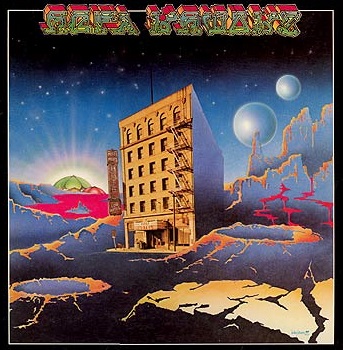Terrapin...
I can't figure out... if it's the end or beginning?
But the trains put it's brakes on...
and the whistle is screaming...
Terrapin!
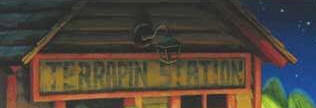 Amidst the
smoke and confusion... the billow of steam and receding trill of the whistle... as the
very mystery train that brought you, pulls away from the
station...
now picking up speed...
doppler shift from red to blue... flying down the track and into darkness... you suddenly find
yourself standing upon a wooden, somewhat rickety disembarking platform. Faded
red rose... blue light
rain... Welcome to Terrapin Station... making
connections to... parts unknown.
Amidst the
smoke and confusion... the billow of steam and receding trill of the whistle... as the
very mystery train that brought you, pulls away from the
station...
now picking up speed...
doppler shift from red to blue... flying down the track and into darkness... you suddenly find
yourself standing upon a wooden, somewhat rickety disembarking platform. Faded
red rose... blue light
rain... Welcome to Terrapin Station... making
connections to... parts unknown.
The Grateful
Dead experience, picking up a head of steam around 1969 and
continuing until Jerry's death on August 9th, 1995... occupied
an amazing niche in popular culture during the last half of the
twentieth century. In their live performances, the Dead tapped
into the richness of the collective unconscious of the audience
and
seemingly
"channeled" the emotive and psychic energies of those in
attendance. In this sense, a Dead concert was a shared
experience between the band and the audience. Dead performances
were... "by design... not consciously planned, often reaching
their artistic peak when the collective stumbled upon something
stunning, when 'the music played the band,' as it were."
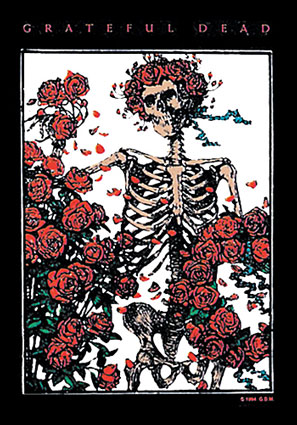 In
retrospect, the Grateful Dead experience was nothing shy of a
contemporary revival of the ancient Gnostic Mystery School
tradition. The roots of the western mystery tradition were
evidenced in the occult movements of Late Antiquity,
Roman-Hellenistic religions which in turn claimed to originate
in ancient Egypt, Chaldea, Persia or other parts of the ancient
world.
In
retrospect, the Grateful Dead experience was nothing shy of a
contemporary revival of the ancient Gnostic Mystery School
tradition. The roots of the western mystery tradition were
evidenced in the occult movements of Late Antiquity,
Roman-Hellenistic religions which in turn claimed to originate
in ancient Egypt, Chaldea, Persia or other parts of the ancient
world.
For the "DeadHeads"
(as the band's fans were known) those who were "in on the
secret" and followed the band on tour... their
Road to Eleusis became the next venue, the next city that
the Grateful Dead was scheduled to play.
The Dead's
persona and presentation could be described as a modern manifestation of what
anthropologists have identified as a "Cult
of the Dead." The ancient Cults of the Dead were based
upon the beliefs that the dead may possess the ability to
influence the fortune of the living (see the Dead mythology
section below). Musically, this tradition was evidenced in the
Afro-Diasporic quality of Jazz and the Blues. Dead albums
and concerts were festooned with "Scull and Roses" imagery,
thereby setting a specific aesthetic 'vibe'. In this regard, a Dead show shared the festive
atmosphere and cultural importance of modern day examples, such
as the observance of Halloween in N. America and the "Día de
Muertos" or Day of the Dead, celebrated throughout Mexico.
Through their use of ancient archetypical symbols such as the scull
and the rose, their improvisational musical sensibilities and their
poetic lyrical genius, the Dead were the heir apparent to these
archaic traditions. In this sense, the Dead could best… and quite possibly only… be
explained through direct, first-hand knowledge or Gnosis.
Mythologist
Joseph Campbell had
this to say concerning the Grateful Dead…
“And what is it?
The first thing I thought of was the Dionysian festivals, of
course. This energy and these terrific instruments with electric
things that zoom in... This is more than music. It turns
something on in here (the heart). And what it turns on is life
energy. This is Dionysus talking through these kids.”
The Dionysian Mysteries were a
ritual of ancient Greece and Rome which used intoxicants and other
trance-inducing techniques (like dance and music) to remove
inhibitions and social constraints, liberating the individual to
return to a natural state. This description of the ancient
mysteries, which were observed from as early as 500 BCE, is
exceedingly consistent with the experience of a Grateful Dead
concert of the late 20th century.
The groundwork for the mystical
component that was a Grateful Dead concert had been laid in the
1960s, as the band (then known as The Warlocks) performed as the
house band for LSD-fueled parties hosted by Oregon author Ken Kesey,
which would later evolve into prototypical multimedia shows known as
the Acid Tests. Kesey was made famous by authoring One Flew over
the Cuckoo’s Nest, in 1962 and Sometimes a Great Notion
in 1964. Kesey was made infamous by travelling cross-country in a
day-glow painted school bus named “Furthur” on expedition from the
west coast to the 1964 World’s Fair in NYC.
Kesey’s “trip” to New York and
back was instrumental in developing the mythos of the Merry
Pranksters, Kesey’s cohorts or “partners in crime” of the era. The
Pranksters created the Acid Tests to further expand the
experimentation that began while on
Furthur. In the vernacular of
Kesey and the Pranksters, you were either on the bus, or off the
bus. Although the Dead remained close friends with Kesey et
al, they soon developed their own unique and epic scene that was
best described to the uninitiated by using the simple statement
(code)... "there's nothing like a Grateful Dead show."
As the 70's disco fury faded,
the Dead's stage performances evolved into Rock-n-Roll ritual.
Patterns emerged in the chaos. First sets were typically comprised
of what might be described as "standard" tunes, where the form or
structure of each song was handled in a traditional manner. First
sets were fun, but they were not what the audience came to
experience. Second sets were improvisational free-for-alls where one
tune would segue... melt might be a more precise term... into the
next, in a seamless, masterful, seemingly effortless movement.
And right smack in the middle of
the jam... rising up... rattling one's rib-cage... like a primordial
neolithic Shamanic rite... menacing, yet inviting... intoxicating...
rising up... the great Pan emerging from Arcadia to the drum beat
that was... The Rhythm Devils. Yeah that was
immaculate...
If this is sounding a little too
crazy... for those of you not familiar
with the Grateful Dead... some perspective. Here is a very short history of the band...
Considered by many to
be the heart and soul of the band, Jerry Garcia played with a
number of acts between 1960 and 1965 before finding musicians
Bill Kreutzman, Bob Weir, Ron Mckernan and Phil Lesh, who would
become the Warlocks original lineup. They finally stumbled on
the phrase Grateful Dead in a randomly opened dictionary. The
words referred to a genre of folktales in which a Good Samaritan
arranges for the burial of a penniless stranger. At some point
later, the Samaritan encounters life-threatening peril and is,
himself, aided by the spirit of the man he helped bury, hence
"grateful dead."
 The
Dead lived at 710 Ashbury Street, and became synonymous with the
1967 Summer of Love cultural movement centered in the San
Francisco Haight-Ashbury neighborhood. The group took influences
from all over -- rock, country, folk and blues -- and forged a
defining sound.
The
Dead lived at 710 Ashbury Street, and became synonymous with the
1967 Summer of Love cultural movement centered in the San
Francisco Haight-Ashbury neighborhood. The group took influences
from all over -- rock, country, folk and blues -- and forged a
defining sound.
The group's mission
statement as voiced by Garcia in 1967: "We're trying to make
music in such a way that it doesn't have a message for anybody.
We don't have anything to tell anybody. We don't want to change
anybody. We want people to have the chance to feel a little
better. That's the absolute most we want to do with our music.
The music that we make is an act of love and act of joy...we're
not telling [anybody] to go get stoned, or drop out.... We are
trying to make things groovier for everybody so more people can
feel better more often, to advance the trip, to get higher -
however you want to say it - but we're musicians and there's
just no way to put the idea 'save the world' into music."
As the band, and its
sound, matured over thirty years of touring, playing, and
recording, each member's stylistic contribution became more
defined, consistent, and identifiable. Phil Lesh, who was originally
a classically-trained trumpet player with an extensive
background in music theory, did not tend to play traditional
blues-based bass forms, but opted for more melodic, symphonic
and complex lines, often sounding like a second lead guitar, a
style that came to be known by fans as: the Phil
Zone.
Weir, too, was not a traditional rhythm guitarist, but tended to
play jazz-influenced, unique inversions at the upper end of the Dead's sound.
The two drummers, Mickey Hart and
Billy Kreutzman,
developed a unique, complex interplay, balancing Kreutzman's
steady beat with Hart's interest in percussion styles outside
the rock tradition. Hart incorporated an 11-count measure to his
drumming, bringing a new dimension to the band's sound that
became an important part of its emerging style. The two drummers
evolved and developed their own persona at live
performances known as: the Rhythm Devils.
Garcia's lead
lines were fluid, supple and spare, owing a great deal of their
character to his training in fingerpicking and banjo. His
improvisational lead guitar style, in the tradition of jazz
pioneers such as Miles Davis and John Coltrane, opened up the
Band's overall expressive presentation, allowing for extensive
musical exploration.
Of historical note is the Band's
practice of allowing fans to tape performances. Over the years, as
the Dead's touring protocol evolved, the Band provided a "tapers
section" at concerts where industrious individuals set up
elaborate, state-of-the-art recording equipment. This allowed fans
the opportunity to "capture the magic" that was a Grateful Dead
performance... on tape... and distribute the recordings free of any
royalty fee. This practice pre-dated and pioneered the "peer to
peer" phenomenon that changed the face of our modern day music industry.
For thirty years, the Grateful
Dead created a musical space that transcended entertainment. The
Dead's concerts became a traveling tabernacle for the DeadHeads. The dynamic songwriting team of
Hunter (lyrics) & Garcia (music) as well as Barlow & Weir... provided
fans with a wonderful musical tapestry of imagery and emotion that
imparted reflection and contemplation and hence expanding the
opportunity for internal processing. The experience of attending a DeadShow provided context to the crazy world that was the final
third of the twentieth century.

To get to Terrapin...
Within the
epic mythological experience that was the Grateful Dead, the
song Terrapin Station played a central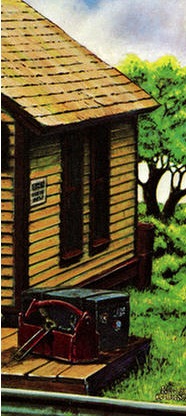 role. Terrapin Station,
the words of which were written by Robert Hunter and the
accompanying music written by Jerry Garcia (August 1, 1942 – August 9, 1995) became one of the Dead’s
central and most profound second set performance pieces. The rich,
archetypical imagery of the sailor, the soldier and of course,
the lady... conjured the deeply emotional dichotomy of what it
means to be human... of love lost and striven for. All of which
is foretold throughout the song, by the ever-present
storyteller.
role. Terrapin Station,
the words of which were written by Robert Hunter and the
accompanying music written by Jerry Garcia (August 1, 1942 – August 9, 1995) became one of the Dead’s
central and most profound second set performance pieces. The rich,
archetypical imagery of the sailor, the soldier and of course,
the lady... conjured the deeply emotional dichotomy of what it
means to be human... of love lost and striven for. All of which
is foretold throughout the song, by the ever-present
storyteller.
In the
opening "Lady with a Fan" movement of the suite, the
storyteller invokes the muse with a prayer-like supplication in
the manner of the Greek poets...
"Let my inspiration flow... in token rhyme, suggesting
rhythm... let it not forsake me, till my tale is told and done."
As the tale
begins, we are transported to a setting of an eternal love
triangle. However, the thematic conflict is not necessarily
between the characters, but of whether the pursuit of love is
wise or folly? These characters are faced with decisions we all
must make. Is the risk of vulnerability worth the reward of true
love? As Lady with a Fan concludes, we are reminded
of the proper role of the storyteller...
"Storyteller makes no choice, soon you will not hear his
voice. His job is to shed light... and not to master."
Immediately
following this line, we are given a reminder (and warning) into
the true nature of the currency that the storyteller trades
in...
"Since the end is never told, we pay the
teller off in gold, in hopes he will come back... but he cannot
be bought or sold!"
After the
narrative of Lady with a Fan movement
concludes, the central theme of Terrapin Station explodes with
the emotive lyric, in the voice of the storyteller…
Inspiration! …move me brightly! This line
continues the opening theme of supplication, in keeping
with the ancient Greek tradition. Here the theme of the suite
subtly broadens. Terrapin’s lyrics reveal the
connotation that Terrapin
Station is the Earth herself…
in the
shadow of the moon. With this broadening, the suite suggests
a deeper, esoteric consideration, and we are challenged to
contemplate, what are the true ramifications of our existence
on Terrapin Station? For...
"Some
rise... some fall... some climb... to get to Terrapin."
The song builds in intensity, culminating in
the
syncopated proclamation…
"Terrapin! I can’t figure out… (terrapin!) if it’s the end or
beginning… (terrapin!) but the train’s put it’s brakes
on…
(terrapin!) and the whistle is screaming… Terrapin!"
Hunter's
brilliance in lyrical subtleties shines forth as layers of
allegory maintain multiple streams of narrative. The unfolding
folk tale and mythic creation epic exuded quandary. The song's
existential questions are of course not answered, but as this
piece of music was performed live and as the quite dramatic
instrumental ending would slowly unfold and segue into new,
unique
musical territory each night it was performed, those of us in
attendance at this 20th century Mystery Cult were reminded that Terrapin Station was...
and is, indeed... a rare & different tune.

Grateful
Dead...
the Mythology
The Grateful Dead (or
grateful ghost) is a folktale present in many cultures
throughout the world. The most common story involves a traveler
who encounters a corpse of someone who never received a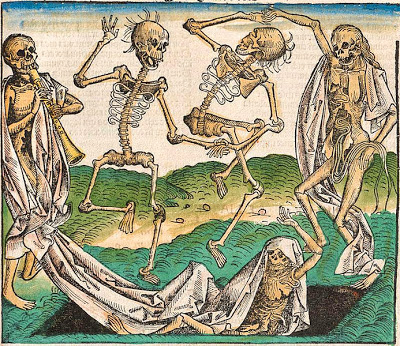 proper
burial, typically stemming from an unpaid debt. The traveler
then either pays off the dead person's debt or pays for burial.
The traveler is later rewarded or has their life saved by a
person or animal who is actually the soul of the dead person;
the grateful dead is a form of the donor archetype.
proper
burial, typically stemming from an unpaid debt. The traveler
then either pays off the dead person's debt or pays for burial.
The traveler is later rewarded or has their life saved by a
person or animal who is actually the soul of the dead person;
the grateful dead is a form of the donor archetype.
In
fairy tales, a donor is a character that tests the hero (and
sometimes other characters as well) and provides magical
assistance to the hero when he succeeds. An example of the donor
archetype, found in European folktales from the middle
ages, is the "fairy godmother."
Actual fairy godmothers are rare
in fairy tales, but became familiar figures because of the
popularity of the literary fairy tales of Madame d'Aulnoy and
Charles Perrault's tale, Cinderella. Many other supernatural
patrons feature in fairy tales; these include various kinds of
animals and the spirit of a dead mother. The fairy godmother has
her roots in the figures of the Fates; this is especially clear
in The Sleeping Beauty, where they decree her fate, and are
associated with spinning.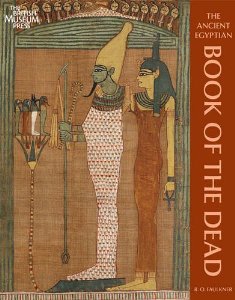
A variant of the grateful dead motif is found in the the Book of Tobit. The chivalric romance "Amadas"
has the title knight pay his last coins for such a burial. This
motif appears in various fairy tales, such as the Italian Fair
Brow, the Swedish The Bird 'Grip' and H. C. Andersen's The
Traveling Companion.
Going further back, an Ancient Egytian text explains the principle of reciprocity in which the
deceased calls for a blessing on the person who remembers his
name and helps him into a happy afterlife:
"But if there be a man, any one whomsoever, who beholdeth
this writing and causeth my soul and my name to become
established among those who are blessed, let it be done for him
likewise after his final arriving (at the end of life's voyage)
in recompense for what was done by him for me, Osiris."

Grateful
Dead...
the
Science
Fiction
Watch your head as you enter
the low-orbiting, self-sustaining
space station we call Terrapin. We are a "freeport" station, in
that we operate outside of national identity or national
jurisdiction. As such, Terrapin is home to a prototypical
galactic citizenry. As
 we circle our home world... our "bright blue ball just spinning,
spinning free"
...we are constantly reminded of the global perspective that we
are all fellow
passengers aboard spaceship earth.
we circle our home world... our "bright blue ball just spinning,
spinning free"
...we are constantly reminded of the global perspective that we
are all fellow
passengers aboard spaceship earth.
As a freeport station, we provide access to all points off-world. In addition
to being a gateway to our solar system and beyond, Terrapin Station acts as
a repository for a wide assortment of galactic databanks, both Terran and
extra-terrestrial.
Terrapin Station was salvaged from the decaying soviet
and U.S. space programs,
and is manned and maintained by an unlikely confederation of techno-gurus
from Silicon Valley, scientists from the Jet Propulsion Laboratory and
Deadhead tapers from San Francisco. Our mission is to provide access to our
many database archives, facilitate the global perspective of
spaceship earth and to assist in transporting our
understanding of what it means to be human a little
furthur along as we travel
outside earth's gravity well and into the unknown.

In addition to the various databanks found below,
Terrapin Station acts as a
transmitter of “Radio Free Dead” ...the Tek-Gnostics pirate radio station.
We consider this a public service for our galactic community. We
maintain other archival materials pertaining to Jehovah's favorite choir.
Follow the links below for more information, and remember:
Once
in a while you get shown the light... in the strangest of places... if
you look at it right !
